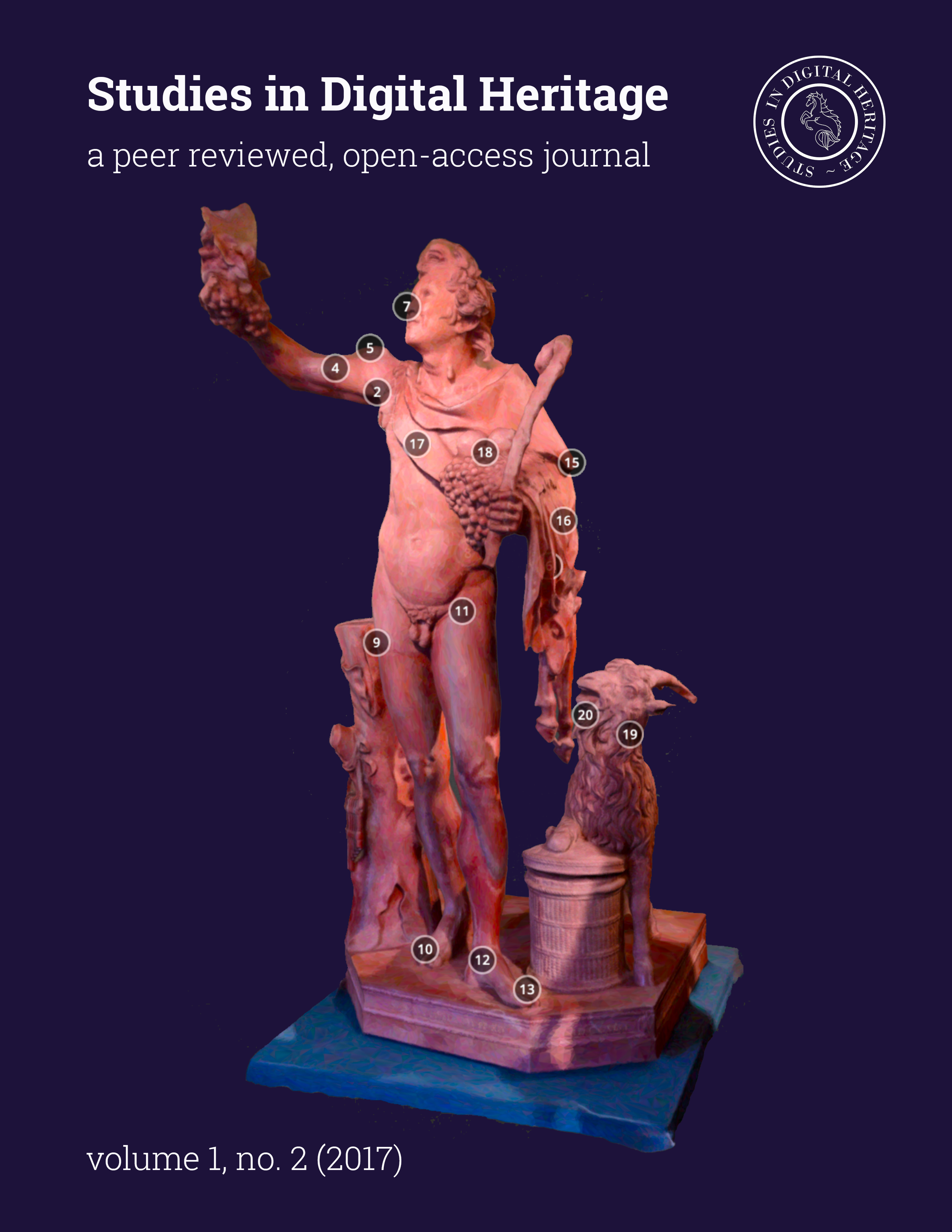New Technologies in the Preservation of Cultural Artifacts with Spatial, Temporal, Corporeal, Kinetic Dimensions: Artifacts in the Trinidad Carnival
Main Article Content
Abstract
Downloads
Article Details
From 18 May 2018, the contents of Studies in Digital Heritage are licensed under a Creative Commons Attribution-NonCommercial 4.0 International License (CC BY-NC 4.0). Our submitting authors pay no fee and retain the copyright to their own work.
How this works: to submit their work to the journal, authors grant Studies in Digital Heritage a nonexclusive license to distribute the work according to a CC BY-NC 4.0 license. Once an article is published, anyone is free to share and adapt its contents—provided only that they do so for noncommercial purposes and properly attribute the shared or adapted information. Details of these terms can be found on the Creative Commons website.
Download SDH’s full author agreement here
Studies in Digital Heritage will insert the following note at the end of any work published in the journal:
© [Year] by the authors. This article is an open-access article distributed under the terms and conditions of the Creative Commons Attribution License CC BY-NC 4.0 (https://creativecommons.org/licenses/by-nc/4.0/).
References
Brown, Ernest D. 1990. “Carnival, Calypso, and Steelband in Trinidad.” The Black Perspective in Music 18 (1/2): 81–100. doi:10.2307/1214859.
“Callaloo by Minshall.” 1986. Riverside Studios in association with the Commonwealth Institute.
Carr, Andrew T. 1956. “Pierrot Grenade.” Caribbean Quarterly 4 (3/4): 281–314. doi:10.2307/40652642.
Chen, Ching-chih, Howard D. Wactlar, James Z. Wang, and Kevin Kiernan. 2005. “Digital Imagery for Significant Cultural and Historical Materials.” International Journal on Digital Libraries 5 (4): 275–86. doi:10.1007/s00799-004-0097-5.
Crowley, Daniel J. 1956a. “The Midnight Robbers.” Caribbean Quarterly 4 (3/4): 263–74. doi:10.2307/40652640.
Crowley, Daniel J. 1956c. “The Traditional Masques of Carnival.” Caribbean Quarterly 4 (3/4): 194– 223.
Dourish, Paul. 2004. Where the Action Is: The Foundations of Embodied Interaction. MIT Press.
Gulick, Todd. 2000. “Lifetime Achievement Award for Innovation in Arts & Culture - Nomination of Minshall.”
Harris, Max. 1998. “The Impotence of Dragons: Playing Devil in the Trinidad Carnival.” TDR (1988-) 42 (3): 108–23.
Hill, Errol. 1972. The Trinidad Carnival: Mandate for a National Theatre. University of Texas Press Austin. http://www.getcited.org/pub/101303599.
Hill, Errol. 1985. “Traditional Figures In Carnival: Their Preservation, Development and Interpretation.” Caribbean Quarterly 31 (2): 14–34.
Kang, Y., S. Wu, Y. A. Ko, K. Martin, and H. S. Ko. 2013. “Digital Production of Traditional Costumes.” In 2013 Digital Heritage International Congress (DigitalHeritage), 1:239–42. doi:10.1109/DigitalHeritage.2013.6743742.
Karadag, Recep. 2014. “Some Non-Destructive and Micro-Analytical Methods for the Conservation on Textiles from Cultural Heritage.” In . Austria, Vienna. http://www.chnt.at/wpcontent/uploads/eBook_CHNT19_Karadag.pdf.
Lee, Ann. 1991. “Class, Race, Colour and the Trinidad Carnival.” Social and Occupational Stratification in Contemporary Trinidad & Tobago, St Augustine: Institute of Social and Economic Research, 417–33.
Liverpool, Hollis. 2001. Rituals of Power and Rebellion: The Carnival Tradition in Trinidad and Tobago, 1763-1962. Frontline Distribution International.
Liverpool, Hollis Urban. 1998. “Origins of Rituals and Customs in the Trinidad Carnival: African or European?” TDR (1988-) 42 (3): 24–37.
Martin, Carol. 1998. “Trinidad Carnival Glossary.” TDR (1988-) 42 (3): 220–35.
Martin, K., and H. S. Ko. 2009. “Virtual Historic Costume across Cultures and Disciplines.” In 2009 15th International Conference on Virtual Systems and Multimedia, 104–8. doi:10.1109/VSMM.2009.21.
Martin, K., and H. S. Ko. 2011. “Imagining Historic Fashion: Digital Tools for the Examination of Historic Dress.” In 2011 Second International Conference on Culture and Computing, 51–56. doi:10.1109/Culture-Computing.2011.18.
Martin, K., and D. Mauriello. 2013. “3D Simulation: A New Embodiment for Historic Fashion.” In 2013 International Conference on Culture and Computing (Culture Computing), 62–67. doi:10.1109/CultureComputing.2013.19.
Minshall, Peter. 1987. “Minshall: Works in the Mas Presented in the Carnival of Trinidad.”
Minshall, Peter. 1990. “From the Bat to the Dancing Mobile: Technology in Mas (Illustrative Essay).”
MINSHALL, PETER. 2000. “Made in Trinidad.” Caribbean Quarterly 46 (3/4): 95–117. doi:10.2307/40654166
Nagakura, Takehiko, and Woongki Sung. 2014. “Ramalytique: Augmented Reality in Architectural Exhibitions.” In . Austria, Vienna. http://www.chnt.at/wpcontent/uploads/eBook_CHNT19_Nagakura_Sung.pdf.
“NARRIE APPROO.” 2017. The Caribbean Memory Project. Accessed January 29. http://www.caribbeanmemoryproject.com/approo-narrie.html.
Nicholls, Robert W. 1999. “The Mocko Jumbie of the U.S. Virgin Islands; History and Antecedents.” African Arts 32 (3): 49–96. doi:10.2307/3337709.
Noel, Vernelle A. A. 2013. “Trinidad Carnival: Improving Design through Computation and Digital Technology.” Masters Thesis, Cambridge, Mass: Massachusetts Institute of Technology.
Noel, Vernelle A. A. 2016a. “Crafting as Inquiry into Computation - Exploring Wire-Bending in Traditional Practice and Design Education.” Herneoja, Aulikki; Toni Österlund and Piia Markkanen (Eds.), Complexity & Simplicity - Proceedings of the 34th eCAADe Conference Volume 1, University of Oulu, Oulu, Finland, 22-26 August 2016, Pp. 311-320. http://papers.cumincad.org/cgi-bin/works/Show?_id=ecaade2016_075.
Noel, Vernelle A. A. 2016b. “H(EC)I – Human Ethno-Computational Interaction: (Re)Conceptualizing Wire-Bending and Design in the Trinidad Carnival.” Digital Craftsmanship: HCI Takes on Technology as an Expressive Medium. April 20. http://digitalcraft.media.mit.edu/index.php/2016/04/20/heci-human-ethno-computationalinteraction-reconceptualizing-wire-bending-and-design-in-the-trinidad-carnival/.
Noel, Vernelle A. A. 2017. “From Costuming and Dancing Sculptures to Architecture: The Corporeal and Computational in Design and Fabrication of Lightweight Mobile Structures.” In Future Trajectories of Computations in Design. CAAD FUTURES 2017, TASKISLA Campus, Istanbul Technical University, Istanbul, Turkey.
Noel, Vernelle A.A. 2015. “The Bailey-Derek Grammar: Recording the Craft of Wire-Bending in the Trinidad Carnival.” Leonardo 48 (4): 357–65. doi:10.1162/LEON_a_01089.
Pearse, Andrew. 1956. “Carnival in Nineteenth Century Trinidad.” Caribbean Quarterly 4 (3/4): 175– 93. doi:10.2307/40652634.
Procope, Bruce. 1956. “The Dragon Band or Devil Band.” Caribbean Quarterly 4 (3/4): 275–80. doi:10.2307/40652641.
Reddy, Michael J. 1979. “The Conduit Metaphor: A Case of Frame Conflict in Our Language about Language.” In Metaphor and Thought, 284–97. Cambridge: Cambridge University Press.
Riggio, Milla Cozart. 2004a. Carnival: Culture in Action—the Trinidad Experience. New York: Routledge.
Riggio, Milla Cozart. 2004b. Carnival: Culture in Action – The Trinidad Experience. Routledge.
Ryan, Selwyn D, and Institute of Social and Economic Research. 1991. “Social and Occupational Stratification in Contemporary Trinidad and Tobago.” In . Institute of Social and Economic Research, University of the West Indies.
Stiny, G., and Wj Mitchell. 1978. “Palladian Grammar.” Environment and Planning B-Planning & Design 5 (1): 5–18. doi:10.1068/b050005.
Tull, Jo-anne. 2005. “Money Matters – Trinidad and Tobago Carnival 2005.” In . Trinidad and Tobago. http://www.academia.edu/326827/_Money_Matters_in_the_Trinidad_Carnival_.


